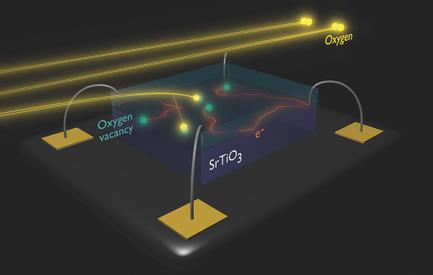当前位置:
X-MOL 学术
›
Adv. Electron. Mater.
›
论文详情
Our official English website, www.x-mol.net, welcomes your
feedback! (Note: you will need to create a separate account there.)
Controlling the Carrier Density of SrTiO3‐Based Heterostructures with Annealing
Advanced Electronic Materials ( IF 5.3 ) Pub Date : 2017-06-26 , DOI: 10.1002/aelm.201700026 Dennis V. Christensen 1 , Merlin von Soosten 1 , Felix Trier 1 , Thomas S. Jespersen 2 , Anders Smith 1 , Yunzhong Chen 1 , Nini Pryds 1
Advanced Electronic Materials ( IF 5.3 ) Pub Date : 2017-06-26 , DOI: 10.1002/aelm.201700026 Dennis V. Christensen 1 , Merlin von Soosten 1 , Felix Trier 1 , Thomas S. Jespersen 2 , Anders Smith 1 , Yunzhong Chen 1 , Nini Pryds 1
Affiliation

|
The conducting interface between the insulating oxides LaAlO3 (LAO) and SrTiO3 (STO) displays numerous physical phenomena that can be tuned by varying the carrier density, which is generally achieved by electrostatic gating or adjustment of growth parameters. Here, it is reported how annealing in oxygen at low temperatures (T < 300 °C) can be used as a simple route to control the carrier density by several orders of magnitude. The pathway to control the carrier density relies on donor oxidation and is thus applicable to material systems where oxygen vacancies are the dominant source of conductivity. Using STO capped with epitaxial γ‐Al2O3 (GAO) or amorphous LAO (a‐LAO), the pathways for changing the carrier density in the two STO‐based cases are identified where oxygen blocking (GAO) and oxygen permeable (a‐LAO) films create interface conductivity from oxygen vacancies located in STO near the interface. For a‐LAO/STO, the rate limiting step (Ea = 0.25 eV) for oxidizing oxygen vacancies is the transportation of oxygen from the atmosphere through the a‐LAO film, whereas GAO/STO is limited by oxygen migration inside STO (Ea = 0.5 eV). Finally, it is showed how the control of the carrier density enables writing of conducting nanostructures in γ‐Al2O3/STO by conducting atomic force microscopy.
中文翻译:

通过退火控制基于SrTiO3的异质结构的载流子密度
绝缘氧化物LaAlO 3(LAO)和SrTiO 3(STO)之间的导电界面显示出许多物理现象,这些现象可以通过改变载流子密度来调节,这通常是通过静电选通或调整生长参数来实现的。在这里,据报道如何在低温(T <300°C)的氧气中退火可以用作将载流子密度控制几个数量级的简单途径。控制载流子密度的途径取决于施主氧化,因此适用于氧空位是电导率主要来源的材料系统。使用STO与外延封端的γ-Al 2 ö 3(GAO)或无定形LAO(a‐LAO),在两种基于STO的情况下,可以确定改变载流子密度的途径,其中阻氧(GAO)和透氧(a‐LAO)薄膜会因所存在的氧空位而产生界面电导在接口附近的STO中。对于a‐LAO / STO,氧化氧空位的速率限制步骤(E a = 0.25 eV)是氧气通过a‐LAO膜从大气中的迁移,而GAO / STO受STO内部氧迁移的限制(E a = 0.5 eV)。最后,显示了如何在载流子密度的控制使得能够在γ-Al系导电写入纳米结构的2 ö 3 /通过进行原子力显微镜STO。
更新日期:2017-06-26
中文翻译:

通过退火控制基于SrTiO3的异质结构的载流子密度
绝缘氧化物LaAlO 3(LAO)和SrTiO 3(STO)之间的导电界面显示出许多物理现象,这些现象可以通过改变载流子密度来调节,这通常是通过静电选通或调整生长参数来实现的。在这里,据报道如何在低温(T <300°C)的氧气中退火可以用作将载流子密度控制几个数量级的简单途径。控制载流子密度的途径取决于施主氧化,因此适用于氧空位是电导率主要来源的材料系统。使用STO与外延封端的γ-Al 2 ö 3(GAO)或无定形LAO(a‐LAO),在两种基于STO的情况下,可以确定改变载流子密度的途径,其中阻氧(GAO)和透氧(a‐LAO)薄膜会因所存在的氧空位而产生界面电导在接口附近的STO中。对于a‐LAO / STO,氧化氧空位的速率限制步骤(E a = 0.25 eV)是氧气通过a‐LAO膜从大气中的迁移,而GAO / STO受STO内部氧迁移的限制(E a = 0.5 eV)。最后,显示了如何在载流子密度的控制使得能够在γ-Al系导电写入纳米结构的2 ö 3 /通过进行原子力显微镜STO。











































 京公网安备 11010802027423号
京公网安备 11010802027423号